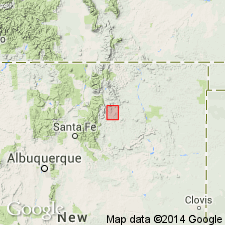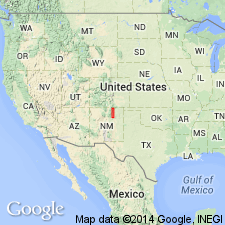
- Usage in publication:
-
- Naranjo formation*
- Modifications:
-
- Original reference
- Dominant lithology:
-
- Sandstone
- Shale
- AAPG geologic province:
-
- Las Vegas-Raton basin
- Sierra Grande uplift
Summary:
Naranjos formation. Sequence of interbedded brownish-red sandstone, siltstone, and shale. Thickness 15 to 64 feet. Overlies Chinle formation; underlies Ocate sandstone (new). Age is Jurassic.
Named from exposures in cutbank near village of Naranjo [Naranjos], about 2 mi east of Ocate, Mora Co., northeastern NM. Present also at Turkey Mountain, 12 mi south of Ocate.
Source: US geologic names lexicon (USGS Bull. 1200, p. 2683).

- Usage in publication:
-
- Naranjo Formation
- Modifications:
-
- Not used
Summary:
Not used at Naranjos, Mora Co, NM, Las Vegas-Raton basin. Rocks at Naranjos disconformably below Entrada Sandstone and disconformably above Bull Canyon Formation (called Chinle Formation in some earlier reports) are assigned to Redonda Formation. Measured sections. Cross sections. Nomenclature chart.
Source: GNU records (USGS DDS-6; Denver GNULEX).
For more information, please contact Nancy Stamm, Geologic Names Committee Secretary.
Asterisk (*) indicates published by U.S. Geological Survey authors.
"No current usage" (†) implies that a name has been abandoned or has fallen into disuse. Former usage and, if known, replacement name given in parentheses ( ).
Slash (/) indicates name conflicts with nomenclatural guidelines (CSN, 1933; ACSN, 1961, 1970; NACSN, 1983, 2005, 2021). May be explained within brackets ([ ]).

